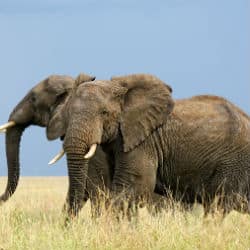Wild Elephants in Europe

Some conservationists have proposed bringing back herds of roaming megaherbivores such as elephants to Europe.
In the past 10,000 to 60,000 years humans have had a hand in wiping out 80% of the worlds large herbivore species weighing over a tonne, known as megaherbivores. For instance the last mammoth died out around 3,700 years ago.
Maintaining diverse habitats
The reason that conservationists have made this suggestion is that large herbivores play a crucial role in maintaining diverse healthy landscapes. Animals such as giraffes and elephants eat trees, shrubs, grasses and herbs, and promote different types and sizes of plants. Elephants, for instance knock over trees, giving more space to grasses, helping savannah to establish. They also disperse seeds across landscapes recycling nutrients in the soil.
Little is known about reintroducing these giant animals so careful study is required. The consequences of reintroducing large herbivore species into ecosystems that have lost them is possible to observe within parts of Kenyan savannah where the exclusion of elephants and giraffes has been organised and monitored.
African Study
A study, carried out over 12 years has looked at how other animals responded within areas that didn’t have elephants and giraffes present. Dung piles of the smaller herbivores (such as zebra, impalas, and gazelles) were studied to see if they favoured being in areas with or without elephants and giraffes.
For the most part it was discovered that the smaller herbivores preferred the zones where elephants and giraffes weren’t. Only zebras seemed to favour the areas with the larger herbivores, and that was perhaps due to their preference for wide open spaces with fewer trees and more grass, which is what the larger herbivores help create.
These findings suggest that reintroduction of megaherbivores will reduce the habitats that smaller herbivores prefer. This is important to realise, especially in areas where certain small herbivores may be endangered. However, reintroduction shouldn’t be totally ruled out.
Small Scale ‘Reintroduction’ Experiments
There are over 100 captive Asian elephants in America which might be allowed to roam freely within large enclosures. If that was to come to pass then that would serve as a valid experiment to see how habitats in a northern hemisphere region coped with reintroduction of megaherbivores.
Another location that has been suggested is Australia where researchers believe that elephants and rhino could reduce wildfires. Larger herbivores are no longer present within Australian habitats so certain plants that when dry help fuel the fires aren’t eaten.
The suggestions of reintroduction in Europe, America and Australia are certainly worthwhile considering. It extends the habitat of endangered animals such as elephants then there is an obvious benefit. If done in small scale experiments then the impact on native vegetation and animals can be observed before large scale releases are considered. It is crucial that reintroduction can’t be done at the detriment to local flora and fauna so a measured and careful approach must be undertaken.



